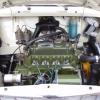From the title of this post, I am experiencing clutch drag yet again. The clutch on my mini is a pre-verto diaphram type. I first thought I got rid of it by replacing the following items:
Release Bearing, Plunger, clutch arm, allthe clevis pins right up to the clutch pedal.
Basically, now, there is no play in the clutch mechanical systam, and I have also made sure to bleed the clutch hydraulic system. I have checked the seals in both the slave and master cylinders, and everything is as new.
Has anyone had a problem like this, considering I have done a complete overhaul? because my gearbox is 3-synchro, its difficult to change to 1st and reverse without grinding. The clutch pedal has to be right to the floor to change gear.
So, I want to try the following: I want to add a little extra length to the end of the slave cylinder push rod, by putting an M10 size cap (acorn) nut on the end of it (loose fit), so the dome end of acorn nut will sit on the piston in the slave cylinder. I would then need to adjust the clutch, as the arm would be in a slightly different position at rest.
Can anyone give advie on this, and if this is a viable method to prevent clutch drag?
Thanks
Edited by mk=john, 12 September 2007 - 04:11 PM.

















